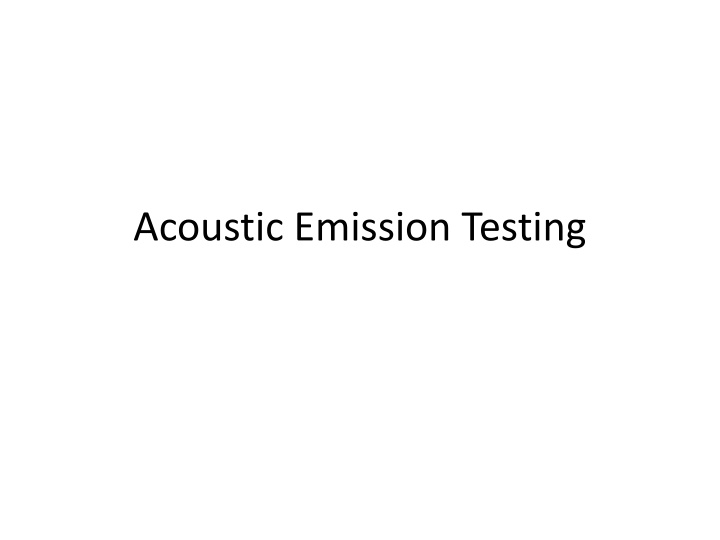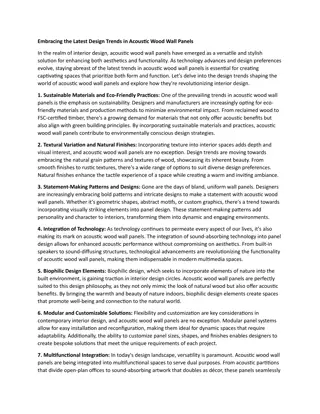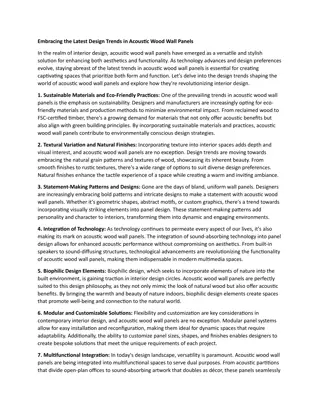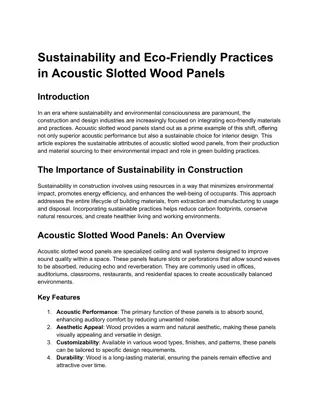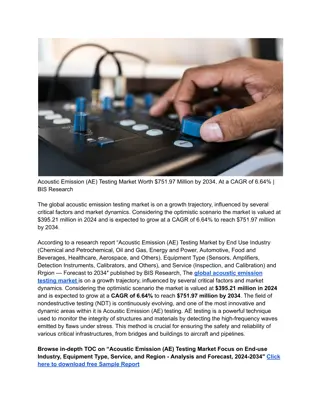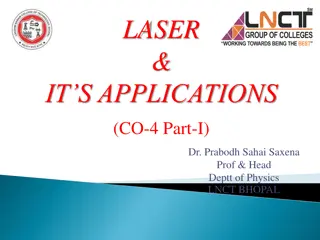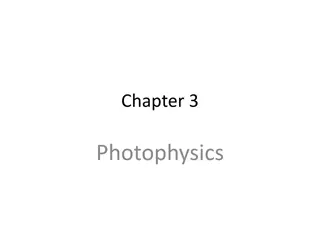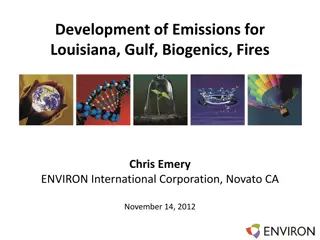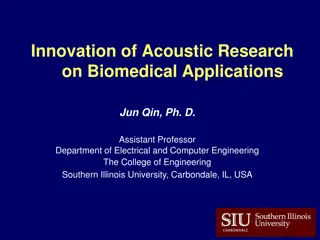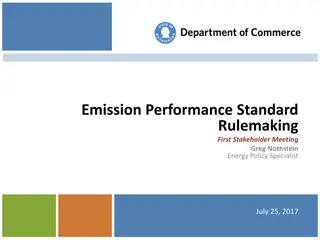Evolution of Acoustic Emission Testing: From Ancient Pottery Makers to Modern Industry
Acoustic Emission (AE) testing has a rich history dating back to ancient times when pottery makers listened for structural failures in their ceramics. Over the years, AE evolved through various experiments, leading to its industrial application in aerospace, nuclear reactors, and more. Today, AE is a widely used non-destructive testing method across industries worldwide to assess structural integrity.
Download Presentation

Please find below an Image/Link to download the presentation.
The content on the website is provided AS IS for your information and personal use only. It may not be sold, licensed, or shared on other websites without obtaining consent from the author.If you encounter any issues during the download, it is possible that the publisher has removed the file from their server.
You are allowed to download the files provided on this website for personal or commercial use, subject to the condition that they are used lawfully. All files are the property of their respective owners.
The content on the website is provided AS IS for your information and personal use only. It may not be sold, licensed, or shared on other websites without obtaining consent from the author.
E N D
Presentation Transcript
Acoustic Emission Testing Introduction to Acoustic Emission Testing Acoustic Emission (AE) refers to the generation of transient elastic waves produced by a sudden redistribution of stress in a material. When a structure is subjected to an external stimulus (change in pressure, load, or temperature), localized sources trigger the release of energy, in the form of stress waves, which propagate to the surface and are recorded by sensors. With the right equipment and setup, motions on the order of pico-meters (10 -12 m) can be identified. AE systems can only qualitatively gauge how much damage is contained in a structure. In order to obtain quantitative results about size, depth, and overall acceptability of a part, other NDT methods (often ultrasonic testing) are necessary. Another drawback of AE stems from loud service environments which contribute extraneous noise to the signals.
Acoustic Emission Testing Early History of AE Probably the first practical use of AE was by pottery makers, thousands of years before recorded history, to asses the quality of there products. As early as 6,500 BC, potters were known to listen for audible sounds during the cooling of their ceramics, signifying structural failure. Probably the first observation of AE in metal was during twinning of pure tin as early as 3700 B.C. Originally called "tin cry" (audible emissions produced by the mechanical twinning of pure tin during plastic deformation) The first documented observation of AE in Middle Ages was made by an Arabian alchemist, Geber, in the eighth century. Geber described the harsh sound or crashing noise emitted from tin. He also describes iron as sounding much during forging.
Acoustic Emission Testing History of First AE Experiments 1920 - noise generated by deformation process of Salt and Zinc crystals was observed. 1936 - Small voltage and resistance variations caused by sudden strain movements caused by martensitic transformations. 1948 - measuring AE to observe the moving dislocations by means of the stress waves they generated. 1950 - twinning experiments on single crystal wires of cadmium. 1950 - tensile tests to determine the characteristics of AE in engineering materials. 1954 - investigated the application of AE in the field of materials engineering and the source of AE. 1957 - Use of AE as a Testing to study the problems of behavior of engineering metals.
Acoustic Emission Testing Start of Industrial Application of AE 1961 - Aerospace industry used AE to verify the integrity of the Polaris rocket motor for the US Navy 1963 - Use of AE for examination of high pressure vessels. 1965 use of AE to detecting the loss of coolant in a nuclear reactor 1969 - First company that specializes in the production of AE equipment. Today, AE used practically in all industries around the world for different types of structures and materials.
Acoustic Emission Testing Theory of Acoustic Emission Acoustic emissions can result from the initiation and growth of cracks, slip and dislocation movements, twinning, or phase transformations in metals. AE s originate when a stress is exerted on a material, a strain is induced in the material as well. Depending on the magnitude of the stress and the properties of the material, an object may return to its original dimensions or be permanently deformed after the stress is removed. These two conditions are known as elastic and plastic deformation, respectively.
Acoustic Emission Testing Theory of Acoustic Emission (Continued) The most detectible acoustic emissions take place when a loaded material undergoes plastic deformation or when a material is loaded at or near its yield stress. On the microscopic level, as plastic deformation occurs, atomic planes slip past each other through the movement of dislocations. These atomic-scale deformations release energy in the form of elastic waves which can be thought of as naturally generated ultrasound traveling through the object. When cracks exist in a metal, the stress levels present in front of the crack tip can be several times higher than the surrounding area. Therefore, AE activity will also be observed when the material ahead of the crack tip undergoes plastic deformation.
Acoustic Emission Testing Theory of Acoustic Emission (Continued) Two sources of fatigue cracks cause AE s. The first source is emissive particles (e.g. nonmetallic inclusions) at the origin of the crack tip. Since these particles are less ductile than the surrounding material, they tend to break more easily when the metal is strained, resulting in an AE signal. The second source is the propagation of the crack tip that occurs through the movement of dislocations and small-scale cleavage produced by triaxial stresses.
Acoustic Emission Testing Theory of Acoustic Emission (Continued) The amount of energy released by an acoustic emission and the amplitude of the waveform are related to the magnitude and velocity of the source event. The amplitude of the emission is proportional to the velocity of crack propagation and the amount of surface area created. Large, discrete crack jumps will produce larger AE signals than cracks that propagate slowly over the same distance. Detection and conversion of these elastic waves to electrical signals is the basis of AE testing. Analysis of these signals yield valuable information regarding the origin and importance of a discontinuity in a material.
Acoustic Emission Testing Acoustic Emission Instrumentation Specialized equipment is necessary to detect the wave energy and decipher which signals are meaningful. Typical AE apparatus consist of the following components: Sensors used to detect AE events. Preamplifiers amplifies initial signal. Typical amplification gain is 40 or 60 dB. Cables transfer signals on distances up to 200m to AE devices. Cables are typically of coaxial type. Data acquisition device performs filtration, signals parameters evaluation, data analysis and charting.
Acoustic Emission Testing Typical Schematic of AE instrumentation Preamplifiers with filters Main amplifiers with filters Measurement Circuitry Sensors Computer Acquisition software Data storage Data presentation
Acoustic Emission Testing AE Sensors AE sensors detect stress wave motion that cause a local dynamic material displacement and converts this displacement to an electrical signal. AE sensors are typically piezoelectric sensors with elements made of special ceramic elements like lead zirconate titanate (PZT). Mechanical strain of a piezo element generates an electric signals. Sensors may have internally installed preamplifier Other types of sensors include capacitive transducers, laser interferometers.
Acoustic Emission Testing Sensors Characteristics Typical frequency range between 30kHz and 1 MHz. Selection of a specific sensor depends on the application and type of flaws to be revealed. Transducers are selected based on operating frequency, sensitivity and environmental characteristics, and are grouped into two classes: resonant and broadband. The majority of AE equipment is responsive to movement in its typical operating frequency range of 30 kHz to 1 MHz. For materials with high attenuation (e.g. plastic composites), lower frequencies may be used to better distinguish AE signals. The opposite holds true as well.
Acoustic Emission Testing Sensors Characteristics (Continued) Two qualitative type of sensors (resonant and wideband sensors.) Thickness of piezoelectric element defines the resonance frequency of sensor. Diameter defines the area over which the sensor averages surface motion. Curie Point, the temperature under which piezoelectric element loses permanently its piezoelectric properties. Curie temperature varies for different ceramics from 120 to 400C0.
Acoustic Emission Testing Installation of Sensors on Structure Type of installation and choice of couplant* material is defined by a specifics of application. Glue (superglue type) is commonly used for piping inspections. Magnets usually used to hold sensors on metal pressure vessels. Grease and oil then used as a couplant. Bands used for mechanical attachment of sensors in long term applications. Waveguides (welded or mechanically attached) used in high temperature applications. Rolling sensors are used for inspection rotating structures. Special Pb blankets used to protect sensors in nuclear industry. *A substance such as water, oil, grease, or paste used to avoid the retarding of sound transmission by air between the transducer and the test piece during ultrasonic examination.
Acoustic Emission Testing Type of installation and choice of couplant material is defined by a specifics of application. Sensor attached with magnet Waveguide Pb blanket in nuclear applications Rolling sensor produces by PAC
Acoustic Emission Testing AE Data Acquisition Devices Example of AE device parameters: 16 bit, 10 MHz A/D converter. Maximum signal amplitude 100 dB AE. 4 High Pass filters for each channel with a range from 10 KHz to 200 KHz (under software control). 4 Low Pass filters for each channel with a range from 100 KHz to 2.1 MHz (under software control). 32 bit Digital Signal Processor. 1 Mbyte DSP and Waveform buffer.
Acoustic Emission Testing Principals of AE Data Measurement and Analysis Threshold and Hit Definition Time (HDT) Threshold and HDT are parameters that used for detection AE signals in traditional AE devices. HDT: Enables the system to determine the end of a hit, close out the measurement process and store the measured attributes of the signal. Long HDT Hit 1 Short HDT Threshold Voltage Short HDT Hit 2 Hit 1 Time Long HDT
Acoustic Emission Testing Principals of AE Data Measurement and Analysis Burst and Continuous AE Signals Burst AE is a qualitative description of the discrete signal's related to individual emission events occurring within the material. Continuous AE is a qualitative description of the sustained signal produced by time-overlapping signals.
Acoustic Emission Testing AE Parameters Peak amplitude - The maximum peak. Energy Integral of the rectified voltage signal/duration Duration Time from the first threshold crossing to the end of the last threshold crossing. Counts Total number that exceeds the threshold. Average Frequency The average frequency in kHz. MARSE - is the measure of the area under the envelope of the rectified linear voltage time signal from the transducer Rise time - The time from the first threshold crossing to the maximum amplitude. Count rate - Number of counts per time unit. Some of these parameter or shown on the following slide
Acoustic Emission Testing AE Parameters
Acoustic Emission Testing Background Noise Background noise significantly affects the result of AE testing and need to be considered and controlled. Types of noise: Hydraulic noise Cavitations, turbulent flows, boiling of fluids and leaks. Mechanical noise Movement of mechanical parts in contact with the structure e.g. fretting of pressure vessels against their supports caused by elastic expansion under pressure. Cyclic noise Repetitive noise such as that from reciprocating or rotating machinery. Electro-magnetic noise.
Acoustic Emission Testing Background Noise Background noise significantly affects the result of AE testing and need to be considered and controlled. Control of noise sources: Rise Time Discriminator There is significant difference between rise time of mechanical noise and acoustic emission. Frequency Discriminator The frequency of mechanical noise is usually lower than an acoustic emission burst from cracks. Floating Threshold or Smart Threshold Varies with time as a function of noise output. Used to distinguish between the background noise and acoustic emission events under conditions of high, varying background noise.
Acoustic Emission Testing AE Source Location Techniques Locating the source of acoustic emissions is often accomplished by one of three methods Linear Location Technique Point Location Zonal Location Technique Many AE systems are capable of using multiple sensors/channels during testing, allowing them to record a hit from a single AE event and then determine the location of an event source. As hits are recorded by each sensor/channel, the source can be located by knowing the velocity of the wave in the material and the difference in hit arrival times among the sensors. By properly spacing the sensors in this manner, it is possible to inspect an entire structure with relatively few sensors.
Acoustic Emission Testing Linear Location Linear location is a time difference method commonly used to locate AE source on linear structures such as pipes. It is based on the arrival time difference between two sensors for known velocity. Sound velocity evaluated by generating signals at know distances. D d
Acoustic Emission Testing Point Location For location of an AE source on a plane two sensors are used. The source is situated on a hyperbola. Three sensors are used to locate a source to a point by intersecting two hyperbolae using the same technique as two sensors. Sensor 2 R2 R3 Sensor 3 Sensor 2 R2 R3 R1 Z D Sensor 1 R1 Sensor 1
Acoustic Emission Testing Zone Location Zone location is based on the principle that the sensor with the highest amplitude or energy output will be closest to the source. Zonal location aims to trace the waves to a specific zone or region around a sensor. Zones can be lengths, areas or volumes depending on the dimensions of the array. With additional sensors added, a sequence of signals can be detected giving a more accurate result using time differences and attenuation characteristics of the wave.
Acoustic Emission Testing Zone Location
Acoustic Emission Testing Sources of AE in Metals Major macroscopic sources of AE in metals are: crack jumps, plastic deformation development, fracturing and de-bonding of hard inclusions Microscopic sources includes dislocation movement, interaction, annihilation, slip formation, voids nucleation, growth and interaction and many other. More then 80% of energy expended on fracture in common industrial metals goes to development of plastic deformation.
Acoustic Emission Testing Applications of AE Acoustic emission is a very versatile, non-invasive way to gather information about a material or structure. Acoustic Emission testing (AET) is be applied to inspect and monitor pipelines, pressure vessels, storage tanks, bridges, aircraft, and bucket trucks, and a variety of composite and ceramic components. It is also used in process control applications such as monitoring welding processes. A few examples of AET applications follow Inspection of Pressure Vessels Weld Monitoring Bucket Truck (Cherry Pickers) Integrity Evaluation Gas Trailer Tubes Bridges Aerospace Structures
Acoustic Emission Testing AE Standards ASME - American Society of Mechanical Engineers ASTM - American Society for Testing and Materials ASNT - American Society for Nondestructive Testing Association of American Railroads Compressed Gas Association European Committee for Standardization Institute of Electrical and Electronics Engineers International Organization for Standardization Japanese Institute for Standardization Japanese Society for Nondestructive Inspection
